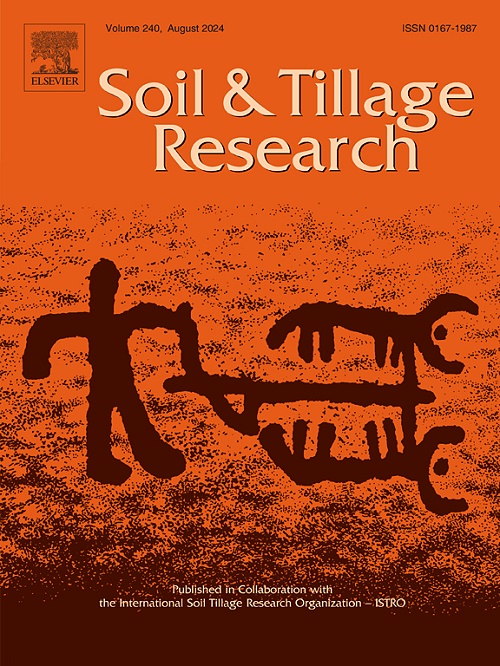Meta-analysis of the effects of different tillage methods on wheat yields under various conditions in China
IF 6.1
1区 农林科学
Q1 SOIL SCIENCE
引用次数: 0
Abstract
Tillage is a useful practice for increasing crop yield, however, its effectiveness is readily influenced by different agro-ecological conditions and cultivation measures. The effects of different tillage methods on wheat yield remain unclear. Therefore, we identified 197 studies and conducted a meta-analysis to determine the effects of three representative tillage methods (no-tillage, subsoiling, and deep ploughing) on wheat yield and soil physicochemical properties according to variations in the mean annual precipitation and temperature, soil texture, soil pH, years of continuous tillage, basic soil fertility, and fertilization level. The average yield increased by 3.5 % under deep ploughing because of the marked decrease in soil bulk density under different production conditions, whereas soil organic carbon and total nitrogen increased significantly, with an average yield increase of 7.0 % under subsoiling tillage. No-tillage overcame the adverse effects of increased soil bulk density on yield by promoting soil carbon and nitrogen accumulation, and had no marked effects on wheat grain yield. The yields increased significantly by 4.5 % after no-tillage for more than seven years. In contrast, deep ploughing tillage initially increased yields, but yields decreased with the number of years under continuous tillage. Overall, subsoiling was the most effective method increasing wheat grain yield and soil physicochemical properties. No-tillage was an effective method under conditions of mean annual precipitation < 400 mm; mean annual temperature < 12°C; loam, neutral or alkaline soil; and medium fertility farmland. Deep ploughing was the most effective in farmlands with low fertilizer levels. The results provide a scientific basis for help agricultural producers to formulate suitable farming practices for appropriate management of production factors.
不同耕作方式对中国不同条件下小麦产量影响的meta分析
耕作是提高作物产量的有效措施,但其效果容易受到不同农业生态条件和耕作措施的影响。不同耕作方式对小麦产量的影响尚不清楚。因此,我们选取了197项研究,并根据年平均降水量和温度、土壤质地、土壤pH、连作年限、土壤基本肥力和施肥水平的变化,进行了meta分析,以确定三种具有代表性的耕作方式(免耕、深耕和深耕)对小麦产量和土壤理化性质的影响。由于不同生产条件下土壤容重显著降低,深耕平均增产3.5 %,土壤有机碳和全氮显著增加,深耕平均增产7.0 %。免耕通过促进土壤碳氮积累克服了土壤容重增加对产量的不利影响,对小麦籽粒产量无显著影响。免耕7年以上,产量显著提高4.5% %。相比之下,深耕耕作初期产量增加,但随着连作年限的增加产量下降。总体而言,深埋土壤是提高小麦籽粒产量和土壤理化性质最有效的方法。在年平均降水量<; 400 mm;年平均气温<; 12°C;壤土,中性或碱性土壤;中等肥力农田。在肥料水平较低的农田,深耕最有效。研究结果为帮助农业生产者制定适宜的耕作方式,合理管理生产要素提供了科学依据。
本文章由计算机程序翻译,如有差异,请以英文原文为准。
求助全文
约1分钟内获得全文
求助全文
来源期刊

Soil & Tillage Research
农林科学-土壤科学
CiteScore
13.00
自引率
6.20%
发文量
266
审稿时长
5 months
期刊介绍:
Soil & Tillage Research examines the physical, chemical and biological changes in the soil caused by tillage and field traffic. Manuscripts will be considered on aspects of soil science, physics, technology, mechanization and applied engineering for a sustainable balance among productivity, environmental quality and profitability. The following are examples of suitable topics within the scope of the journal of Soil and Tillage Research:
The agricultural and biosystems engineering associated with tillage (including no-tillage, reduced-tillage and direct drilling), irrigation and drainage, crops and crop rotations, fertilization, rehabilitation of mine spoils and processes used to modify soils. Soil change effects on establishment and yield of crops, growth of plants and roots, structure and erosion of soil, cycling of carbon and nutrients, greenhouse gas emissions, leaching, runoff and other processes that affect environmental quality. Characterization or modeling of tillage and field traffic responses, soil, climate, or topographic effects, soil deformation processes, tillage tools, traction devices, energy requirements, economics, surface and subsurface water quality effects, tillage effects on weed, pest and disease control, and their interactions.
 求助内容:
求助内容: 应助结果提醒方式:
应助结果提醒方式:


